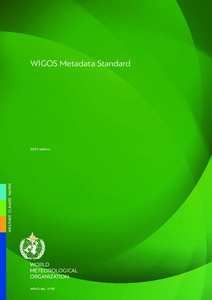| dc.date.accessioned | 2020-07-19T18:38:55Z | |
| dc.date.available | 2020-07-19T18:38:55Z | |
| dc.date.issued | 2019 | |
| dc.identifier.citation | Wold Meteorological Organization (2019) WIGOS metadata standard. 2019 edition. Geneva, Switzerland, World Meteorological Organization 51pp. (WMO-No 1192). DOI: http://dx.doi.org/10.25607/OBP-885 | en_US |
| dc.identifier.isbn | 978-92-63-11192-0 | |
| dc.identifier.uri | http://hdl.handle.net/11329/1379 | |
| dc.identifier.uri | http://dx.doi.org/10.25607/OBP-885 | |
| dc.description.abstract | An important aspect of the WMO Integrated Global Observing System (WIGOS) implementation is ensuring maximum usefulness of WIGOS observations. Observations without metadata are of very limited use: it is only when accompanied by adequate metadata (data describing the data) that the full potential of the observations can be utilized.Two complementary types of metadata are required: discovery metadata and interpretation/description or observational metadata. Discovery metadata facilitate data discovery, access and retrieval. They are WMO Information System (WIS) metadata and are specified and handled as part of WIS. Interpretation/description or observational metadata enable data values to be interpreted in context. They constitute WIGOS metadata and are the subject of this WIGOS standard describing the interpretation metadata required for the effective utilization of observations from all WIGOS component observing systems by all users.The WIGOS metadata should describe the observed variable, the conditions under which it was observed, how it was measured or classified, and how the data have been processed, in order to provide users with confidence that the data are appropriate for their application. In the Manual on the WMO Integrated Global Observing System (WMO-No. 1160), Appendix 2.1, the observing network design principle 10 refers to the need of “Providing information so that the observations can be interpreted” (metadata), while in Appendix 2.2, the Global Climate Observing System (GCOS) Climate Monitoring Principle 2.2.1(c) describes the relevance of metadata as follows: “The details and history of local conditions, instruments, operating procedures, data-processing algorithms and other factors pertinent to interpreting data (that is, metadata) should be documented and treated with the same care as the data themselves.”The WMO Integrated Global Observing System observations consist of an exceedingly wide range of data, from manual observations to complex combinations of satellite hyper-spectral frequency bands, measured in situ or remotely, from single dimension to multiple dimensions, and those involving processing. A comprehensive metadata standard covering all types of observation is by nature complex to define. A user should be able to use the WIGOS metadata to identify the conditions under which the observation, or measurement, was made, and any aspects that may affect its use or understanding, that is, to determine whether the observations are fit for the purpose. | en_US |
| dc.language.iso | en | en_US |
| dc.publisher | World Meteorological Organization | en_US |
| dc.relation.ispartofseries | WMO-No.; 1192 | |
| dc.subject.other | Observations | en_US |
| dc.subject.other | Meteorological instrument | en_US |
| dc.subject.other | Automated Weather Observing System (AWOS) | en_US |
| dc.subject.other | WMO Integrated Global Observing System (WIGOS) | en_US |
| dc.subject.other | Information management | en_US |
| dc.subject.other | Global Space-based Inter-Calibration System (GSICS) | en_US |
| dc.title | WIGOS metadata standard, 2019 edition. | en_US |
| dc.type | Report | en_US |
| dc.description.status | Published | en_US |
| dc.format.pages | 51pp. | en_US |
| dc.contributor.corpauthor | World Meterological Organization | en_US |
| dc.description.refereed | Refereed | en_US |
| dc.publisher.place | Geneva, Switzerland | en_US |
| dc.subject.parameterDiscipline | Parameter Discipline::Atmosphere::Meteorology | en_US |
| dc.subject.dmProcesses | Data Management Practices::Metadata management | en_US |
| dc.description.currentstatus | Current | en_US |
| dc.description.sdg | 13 | en_US |
| dc.description.sdg | 14.A | en_US |
| dc.description.maturitylevel | TRL 9 Actual system "mission proven" through successful mission operations (ground or space) | en_US |
| dc.description.bptype | Best Practice | en_US |
| dc.description.bptype | Standard | en_US |
| obps.contact.contactname | World Meteorological Oganization | |
| obps.contact.contactemail | publications@wmo.in | |
| obps.resourceurl.publisher | https://library.wmo.int/?lvl=notice_display&id=19925#.XxSQ0p5Kg2w | en_US |
 Repository of community practices in Ocean Research, Applications and Data/Information Management
Repository of community practices in Ocean Research, Applications and Data/Information Management
